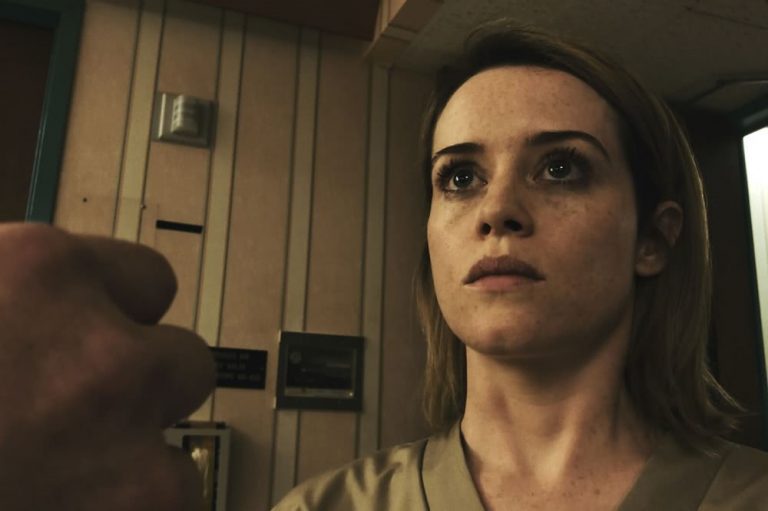After almost 30 years making feature films, TV movies and series, the diversity of Steven Soderbergh’s output has gained him the admiration of critics in particular.
Working across all genres to great success, the director has proven again and again that he is a cinephile in the fuller sense of the term; he cares about genres and their tropes, but also about filmmaking techniques and the possibilities they offer as the medium keeps evolving.
From working fast with a small budget on his first feature (the smash hit modern chamber piece sex, lies and videotape) to crafting a choose-your-own path online visual narrative drama with Mosaic, Soderbergh has demonstrated that he takes cinema seriously, but also creatively: his latest is a conspiracy thriller shot entirely on iPhones.
Sawyer is a woman in the world.
The casting of Amy Irving in Soderbergh’s Unsane is yet another clue to his intelligence (as if anybody doubted it). Claire Foy stars as Sawyer Valentini, a troubled woman kept in a mental facility against her own will, while Irving’s presence as Sawyer’s mother deliberately recalls her own confinement for powerful mental instability as a telekinetic teen in Brian De Palma’s The Fury (1978).
This is a nice, knowing touch — and Irving is always a welcome presence— but it also highlights the gap between De Palma’s and Soderbergh’s efforts, and not to the latter’s advantage. While Irving – literally – saw herself in fantastical scenarios that she couldn’t explain in The Fury, nothing genuinely surreal happens to Foy’s character in Unsane.
Love Film & TV?
Get your daily dose of everything happening in music, film and TV in Australia and abroad.
Here, Soderbergh pays homage to arguably one of the most fanciful American chroniclers of the dark sides of human psychology, but without any of De Palma’s extravagant forays into the eerie and the dreamlike (or the nightmarish).
In Unsane, madness isn’t a spiritual ailment causing visions that can only be described with the vague term of ‘fury,’ but the product of real phenomenon that fully answer to the laws of physics and psychology.
Within minutes of meeting Sawyer, it becomes clear to any viewer that she has experienced her share of harassment. In other words, Sawyer is a woman in the world. Insulted by a client during a phone call at her office job (interestingly, Soderbergh emphasises the fact that the caller was a woman, perhaps to comment on how rampant misogyny can find its way even into the hearts of its victims), discreetly but unmistakably offered career advancement in exchange for hotel room favours by her boss, she emanates a mix of frustration and know-how.

With only a few words, she extricates herself from her boss’ office while letting him down gently, like a savant mouse who has by now learned where all the traps are hidden.
It is in such scenes of muted dialogue and psychological gamesmanship that Claire Foy shows her talent, even though the lines she’s given often seem taken out of a screenwriting manual. Soderbergh’s semi-fish-eye close-ups at once heighten the sense of oppression while letting Foy’s face do all the talking.
Soderbergh doubles down on discomfort via his chosen aesthetic, juxtaposing the dangers posed by men to women with the claustrophobic omnipresence of smartphone technology. The images of exaggeratedly wide eyes and aquarium-like rooms look at once stylised and naturalistic, and when Sawyer’s paranoia about being stalked starts manifesting itself through her irrational behaviour with a Tinder date, the spectator’s unease deepens.
Although ambiguously rendered early on, Sawyer’s fears are never probed by Soderbergh, who is consistently on his character’s side. Even when she mistakenly sees the face of David (Joshua Leonard), the man who has been pursuing her for two years, on the bodies of other men, the director represents her visions faithfully to her experience of reality. She blinks, and David is replaced by the real person standing in front of her.
This dedication to realism is laudable for many reasons. The constant sense of threat that women have to live with is a serious matter; the voyeurism inherent to a time when everything can be recorded, tracked, and data-mined is worthy of scrutiny.
Although ambiguously rendered early on, Sawyer’s fears are never probed by Soderbergh, who is consistently on his character’s side.
In terms of camerawork, employing smartphones to create raggedly cinematic images continues the evolution of filmmaking techniques represented by Sean Baker’s similarly shot Tangerine (2015). But the road to hell is paved with good intentions. In Unsane, unrelenting realism ends up tarnishing the film’s moral righteousness by making its important but predictable provocations seem unnecessarily and unrewardingly direct.
Soderbergh isn’t opaque about his generic intentions. Unsane’s opening titles evoke vintage paranoid thrillers like The Fury or even Alan Pakula’s Klute (a film about toxic masculinity that predates the term). Following Sawyer from afar as she walks down the street and looks around for potential pursuers, the iPhone camera is the stalker. When she enters a mental institution to ask a psychiatrist about her fears, we are far from the exaggeratedly seedy milieu of Seconds (1966), yet the perspective is as slanted as it was in Frankenheimer’s masterpiece.
The situation escalates fast once Sawyer is told the papers that she has casually signed commit her to 24 hours in observation, yet Soderbergh’s realist approach keeps all events thoroughly believable. When she starts seeing David in the face of a male nurse, one hopes that things will start to take off into the bizarre and the fantastic, not as much for the sake of art or play as for a need to be relieved from the heaviness of Sawyer’s very evident and unmistakably real pain.
But they don’t, and what for a moment seemed to be a figment of Sawyer’s imagination is proven to be authentic.David has truly infiltrated the facility as a male nurse, withholding his true identity and strategically making Sawyer seem crazy to the staff (although never to the audience).

Claire Foy in Unsane
Soderbergh’s decision to employ realism as a way to update a somewhat antiquated genre ends up having the opposite effect: Unsane becomes problematic. De Palma’s withholding of information to generate twists and his predilection for ridiculous exaggeration (Hitchcock had his victim killed by a phallic knife, so De Palma opted for a gigantic vibrating power drill) in films such as Body Double or Dressed to Kill have often been judged as simplistic and distasteful (the villain’s crossdressing in the latter film is directly tied to his mental instability and murderous tendencies), yet those films employed those questionable means with a degree of extravagance that took them far from realism – and did so to explore the darker recesses of the mind.
The endless shootout in Scarface is a ridiculous bloodbath, but it’s also a balletic representation of a man broken by power. The impossibly depressing ending of Blow Out feels less like an affront to the audience because of the powerful message it sends about America and personal responsibility.
Soderbergh doesn’t delve into Sawyer’s mind because her mind is clear: it turns out that she has no illusions, and so neither do we. The film doesn’t explore David’s mentality either, but instead has him stand and face some hard truths directly from Sawyer’s mouth. Many reviewers have praised Unsane as fun schlock, but this intense late moment in the facility’s solitary confinement room merely enshrines the script’s pedestrian pop psychology.
By the end, one just wants all the realistic blows and hackneyed psychological remarks to end.
“I love you so much! You must know that at this point!” says David pleadingly, and Sawyer’s exasperation is also our own. It’s uncomfortable, but also redundant, reiterating as it does what we, indeed, already know and don’t necessarily need to think about more deeply.
David’s obsession, and its origin in a male idea of the perfect woman never was a mystery; worse yet, it is a blatantly commonplace and uncomplicated notion. Sawyer’s difficult extrication from her crazed suitor’s grasp becomes the film’s sole thrust and Soderbergh’s decision to make things as realistically nasty as possible along the way slowly turns our boredom into revulsion.
Even though Sawyer’s eventual showdown with her stalker is intensely cathartic, that’s only because it is preceded by a series of gruesome attacks (on top of David’s cliched behaviour).
By the end, one just wants all the realistic blows and hackneyed psychological remarks to end. After such a viscerally satisfactory resolution, I was almost willing to be sympathetic towards Soderbergh’s shock-to-the-system approach to men’s oppression of women.
Yet I found myself again disappointed and troubled by the film’s coda. After refusing his traumatised heroine any illusions for the duration of her incarceration, he suddenly veers into fantasy – and again for only a brief moment. Suggesting that Sawyer’s inner turmoil is here to stay feels at once disrespectful to her (perhaps she really was and is still crazy!) and to the audience – the last freeze frame is just one more bleak ’70s trope.
Soderbergh loves the trickery of heists, as his Ocean’s series and last year’s Logan Lucky make clear, but in a story about mental imbalance and manipulation, such ruses turn him into the oppressor. Soderbergh’s gaslighting of his character and spectator may just be more questionable than De Palma’s pushing of the limits of plausibility for entertainment.
Unsane is out in Australian cinemas next Wednesday April 25. For more film and TV reviews, read our thoughts on Lost In Space here.

































